2013年10月30日
Takamijima
Takamijima is one of 3 islands that joined the Setouchi Triennale for the autumn session. Of all the islands involved in this contemporary art festival, this one is most clearly on the brink of extinction. In its heyday (16th to 18th century), it was populated by close to 1500 people but now there are only 53 left, and most of them are elderly.

Many of the contemporary art installations did a great job of capturing the island’s history and current reality, using materials at hand. One example is House of Pyrethrum. Pyrethrum is a type of chrysanthemum and natural insecticide that was used to make mosquito coils and its cultivation was once a thriving industry on Takajima.
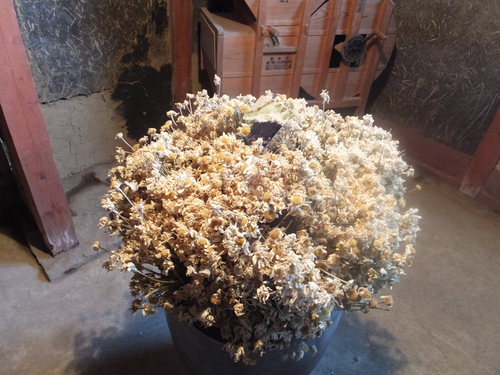
Dried pyrethrum flowers
One elderly resident said she used to climb to the top of the steep island peak every day after school to help bring in the harvest of flowers. That’s quite a climb! You can see the hill and the workers with back racks in the photo of the installation below.

The flowers were then dried and exported off the island for processing. In honor of this lost industry, House of Pyrethrum used every part of the flower – the petals, pistons, etc. – and spread them out over black-lacquered surfaces to produce two striking works. Each square in the photo above and the circle below are made with a different part of the flower. They are spread loose on the surface so don't sneeze near them.

In the loft, the team made a spiral of mosquito cones and burned one a day.

The village on the hill is extremely picturesque and the homes and stone ramparts on which they are built attest to the skill of the Shiwaku carpenters that lived here. The stonewalls and some of the homes as well date back to the Edo period (17th to 19th century).
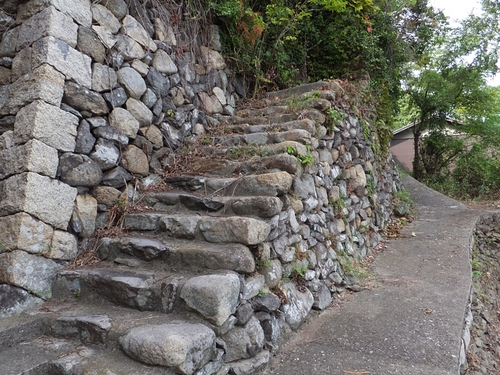

But most of the homes are abandoned. Kayako Nakashima captured the beauty and the decay in her aptly named Transition House.

Here she is explaining the work. She told us that when she first entered an abandoned building, she noticed that the darkness was pierced by pinpoints of light where insects had eaten holes in the wall. Inspired by the beauty of it, she bored hundreds of holes in the walls and roof and filled them with acrylic rods. The effect is quite awe-inspiring.
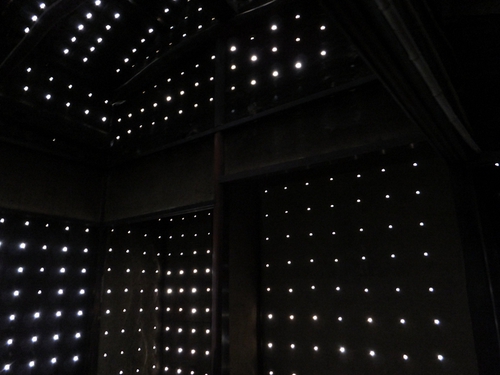
As you can see, this island really captured my imagination, but I am out of space and time so I will continue this in my next post.
For more on the Triennale, see http://setouchi-artfest.jp/en/
Takamatsu Access:
Takamatsu can be reached by direct flights from Tokyo’s Haneda Airport, by express bus from Kansai International Airport (3 hr), and by direct flights from China and Korea. It can also be reached by taking the bullet train to Okayama and changing to the Marine Liner bound for Takamatsu (runs every 1/2 hour; takes 1 hour). For more info see http://wikitravel.org/en/Takamatsu

Many of the contemporary art installations did a great job of capturing the island’s history and current reality, using materials at hand. One example is House of Pyrethrum. Pyrethrum is a type of chrysanthemum and natural insecticide that was used to make mosquito coils and its cultivation was once a thriving industry on Takajima.

Dried pyrethrum flowers
One elderly resident said she used to climb to the top of the steep island peak every day after school to help bring in the harvest of flowers. That’s quite a climb! You can see the hill and the workers with back racks in the photo of the installation below.

The flowers were then dried and exported off the island for processing. In honor of this lost industry, House of Pyrethrum used every part of the flower – the petals, pistons, etc. – and spread them out over black-lacquered surfaces to produce two striking works. Each square in the photo above and the circle below are made with a different part of the flower. They are spread loose on the surface so don't sneeze near them.

In the loft, the team made a spiral of mosquito cones and burned one a day.

The village on the hill is extremely picturesque and the homes and stone ramparts on which they are built attest to the skill of the Shiwaku carpenters that lived here. The stonewalls and some of the homes as well date back to the Edo period (17th to 19th century).


But most of the homes are abandoned. Kayako Nakashima captured the beauty and the decay in her aptly named Transition House.

Here she is explaining the work. She told us that when she first entered an abandoned building, she noticed that the darkness was pierced by pinpoints of light where insects had eaten holes in the wall. Inspired by the beauty of it, she bored hundreds of holes in the walls and roof and filled them with acrylic rods. The effect is quite awe-inspiring.

As you can see, this island really captured my imagination, but I am out of space and time so I will continue this in my next post.
For more on the Triennale, see http://setouchi-artfest.jp/en/
Takamatsu Access:
Takamatsu can be reached by direct flights from Tokyo’s Haneda Airport, by express bus from Kansai International Airport (3 hr), and by direct flights from China and Korea. It can also be reached by taking the bullet train to Okayama and changing to the Marine Liner bound for Takamatsu (runs every 1/2 hour; takes 1 hour). For more info see http://wikitravel.org/en/Takamatsu
Posted by cathy at
17:10
│Comments(0)
2013年10月28日
Awashima Snapshots
Takamatsu makes a great base for enjoying islands and art in the Setouchi Triennale. The final week of this contemporary art festival has been fair and beautiful. I spent these last lovely days joining the hordes of visitors to the 3 islands only open during the Autumn Session. There is far, far too much to see and enjoy, so I will content myself here with sharing just a few snapshots. Let me start with Awashima.

9 AM waiting with several hundred people for a boat that carries only 70 passengers – a great time to chat and make friends.

The boats are crowded but friendly.
Recognizing that the point of this contemporary art festival is to enjoy the islands, we decided to forgo waiting in line with the hordes to see manmade art and instead climbed the peak behind the village to see nature’s art. At 220 meters it was a stiff half-hour climb

and we were hot and sweaty at the top despite the cool autumn weather.

But we had been lured by promises of the 360-degree view and we were not disappointed. The shot below shows Takamajima, the next island on our itinerary.
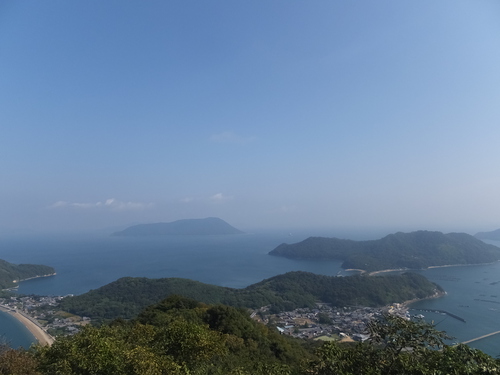
Back at the bottom, we stopped at an art site or two, much less crowded because most people had passed on. The work, Susanoo, which is like walking into a dark cobwebby cave on the first floor, caught my fancy.
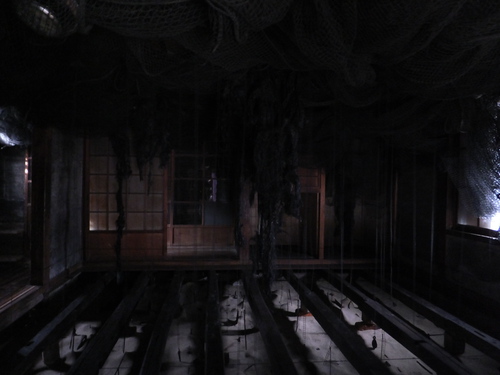
I particularly enjoyed the “art” on the second floor – the thrifty habit of long deceased residents of patching their doors with used letters and newspapers resulted in gorgeous collages that gave the room a nostalgic feel.


Here’s another door that caught my fancy.

Made from a single tree trunk that has been split open like a book. Yes, I know it’s not contemporary art but it is part of the “art” of living and as such is most relevant to this art festival. The Triennale uses art as a vehicle to draw people’s attention to the beauty of what is already there.
Here’s another form of art that you won’t find in most contemporary art exhibits. Homemade sandwiches and gingerale.
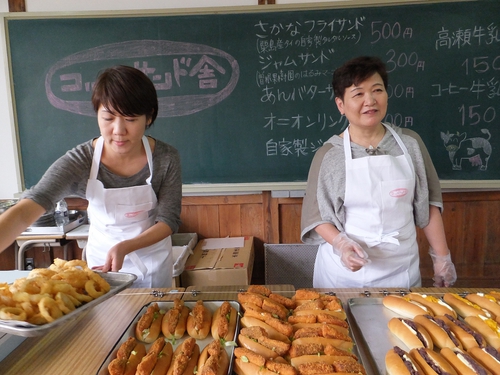

Delicious but how is it art? The food designer and creator studied the area’s products and cuisine, revived a much loved bread roll and stuffed it with local ingredients: freshly caught, deep fried fish fillets and tartar sauce, and cream cheese with either sweet bean jam or marmalade made with locally grown oranges. Mmmm. The “artist’s” goal was to capture people’s hearts and imaginations through their stomachs and she did a good job. The food was all served on tin dishes from the school.
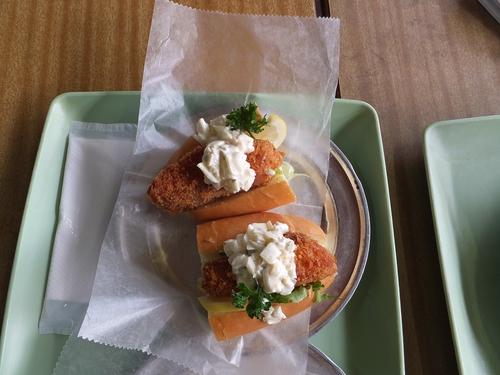
I had been fortunate to try her “art” early in the season before the crowds. In this last week, however, people were lining up for an hour ahead of time to get some, so we opted to enjoy the fare offered at the many booths put up by local chambers of commerce, women’s organizations, young entrepreneurs and others. My favorite was tempura dried anchovies produced by a mother and son from Ibukijima island where anchovy production is the main industry.
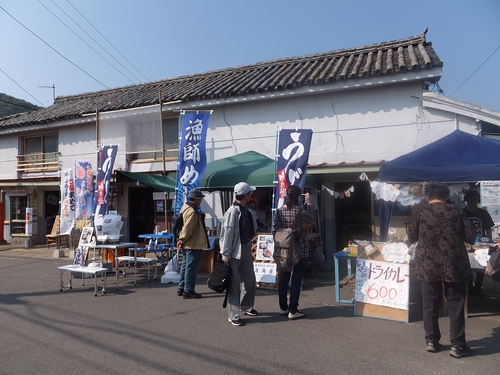
All in all, it was a great way to spend the morning, and we could have stayed all day. The islanders were very open and friendly. They seemed more accustomed to visitors than the other islands, perhaps because the former marine school had students boarding from all over Japan, and many of the local sailors traveled the world. Here are some parting shots.

The old marine school
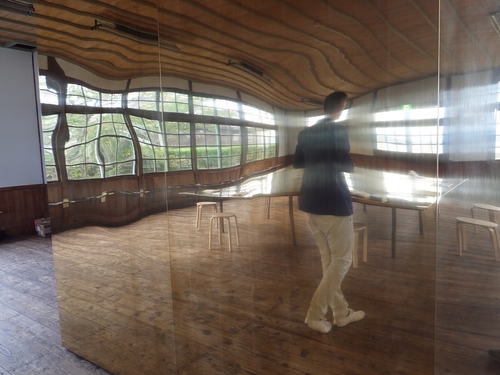
The Sea Library with the artist reflected in the locally made brass partition.
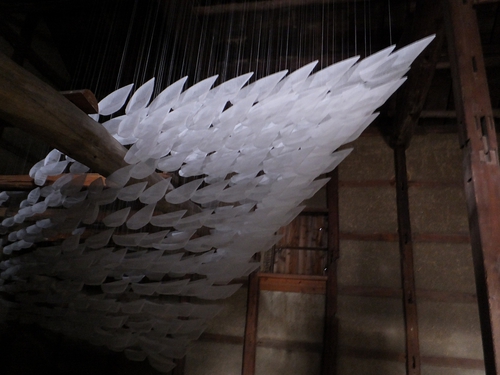
Embarkation, in which artist Syoko Aso expressed her hopes for the islanders to sail on into the future.
For more on the Triennale, see http://setouchi-artfest.jp/en/
Takamatsu Access:
Takamatsu can be reached by direct flights from Tokyo’s Haneda Airport, by express bus from Kansai International Airport (3 hr), and by direct flights from China and Korea. It can also be reached by taking the bullet train to Okayama and changing to the Marine Liner bound for Takamatsu (runs every 1/2 hour; takes 1 hour). For more info see http://wikitravel.org/en/Takamatsu

9 AM waiting with several hundred people for a boat that carries only 70 passengers – a great time to chat and make friends.

The boats are crowded but friendly.
Recognizing that the point of this contemporary art festival is to enjoy the islands, we decided to forgo waiting in line with the hordes to see manmade art and instead climbed the peak behind the village to see nature’s art. At 220 meters it was a stiff half-hour climb

and we were hot and sweaty at the top despite the cool autumn weather.

But we had been lured by promises of the 360-degree view and we were not disappointed. The shot below shows Takamajima, the next island on our itinerary.

Back at the bottom, we stopped at an art site or two, much less crowded because most people had passed on. The work, Susanoo, which is like walking into a dark cobwebby cave on the first floor, caught my fancy.

I particularly enjoyed the “art” on the second floor – the thrifty habit of long deceased residents of patching their doors with used letters and newspapers resulted in gorgeous collages that gave the room a nostalgic feel.


Here’s another door that caught my fancy.

Made from a single tree trunk that has been split open like a book. Yes, I know it’s not contemporary art but it is part of the “art” of living and as such is most relevant to this art festival. The Triennale uses art as a vehicle to draw people’s attention to the beauty of what is already there.
Here’s another form of art that you won’t find in most contemporary art exhibits. Homemade sandwiches and gingerale.


Delicious but how is it art? The food designer and creator studied the area’s products and cuisine, revived a much loved bread roll and stuffed it with local ingredients: freshly caught, deep fried fish fillets and tartar sauce, and cream cheese with either sweet bean jam or marmalade made with locally grown oranges. Mmmm. The “artist’s” goal was to capture people’s hearts and imaginations through their stomachs and she did a good job. The food was all served on tin dishes from the school.

I had been fortunate to try her “art” early in the season before the crowds. In this last week, however, people were lining up for an hour ahead of time to get some, so we opted to enjoy the fare offered at the many booths put up by local chambers of commerce, women’s organizations, young entrepreneurs and others. My favorite was tempura dried anchovies produced by a mother and son from Ibukijima island where anchovy production is the main industry.

All in all, it was a great way to spend the morning, and we could have stayed all day. The islanders were very open and friendly. They seemed more accustomed to visitors than the other islands, perhaps because the former marine school had students boarding from all over Japan, and many of the local sailors traveled the world. Here are some parting shots.

The old marine school

The Sea Library with the artist reflected in the locally made brass partition.

Embarkation, in which artist Syoko Aso expressed her hopes for the islanders to sail on into the future.
For more on the Triennale, see http://setouchi-artfest.jp/en/
Takamatsu Access:
Takamatsu can be reached by direct flights from Tokyo’s Haneda Airport, by express bus from Kansai International Airport (3 hr), and by direct flights from China and Korea. It can also be reached by taking the bullet train to Okayama and changing to the Marine Liner bound for Takamatsu (runs every 1/2 hour; takes 1 hour). For more info see http://wikitravel.org/en/Takamatsu
Posted by cathy at
12:46
│Comments(5)



